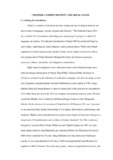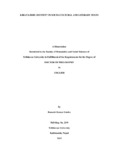Please use this identifier to cite or link to this item:
http://archive.nnl.gov.np:8080/handle/123456789/204| Title: | Kirat-Limbu Identity in Socio-Cultural and Literary Texts |
| Authors: | Limbu, Ramesh Kumar |
| Keywords: | Nepal has been a multi-ethnic, multi-lingual, multi-religious and multi-cultural in nature |
| Issue Date: | 27-Mar-2019 |
| Abstract: | The Limbu, a major community of Kirats inhabiting mostly the area of eastern hilly districts, is one of the indigenous ethnic communities of Nepal. Taking the issues and references primarily from the post-unification to the declaration of democratic republic Nepal, this study analyzes the interactions that took place in historical, political and cultural domains between the state and Kirat-Limbu community in particular and indigenous ethnic groups in general. To achieve this end, socio-cultural and literary analyses of the four literary texts, namely, Bishweswor Prasad Koirala’s novel Sumnima (2009), Rajan Mukarung’s novel Hetchhakuppa (2008), M. K. Limbu’s novel Fragile Mountains (2005) and Desh Subba’s novel Aadibasi (2007) have been objectively carried out. Using critical discourse analysis (CDA) as the theoretical tool for literary inquiry, this research observes the reflection of Limbu ethnicity in the selected literary texts and contexts. In so doing, the study analyses the power dynamics of state ruling ideology and indigenous nationalities of Nepal, and assesses the factors resulting in the formation of Limbu identity. Nepal is a country with ethnic diversity as different groups of people possess distinct languages, cultures, religions, and ways of life. The latest population census (2011) has recorded 125 different nationalities and 123 languages. The communities of Nepal are supposed to have been living in accordance with the state’s nationalistic principle of coexistence, cooperation and brotherhood. Issues of distinctive identities could not come up on the floor in Nepal until the recent past. The question of identities gets prominence only after Nepal moves forward to a new political era and the individuals as well as the people of different communities begin to place themselves within their own groupings. Limbu vii The study investigates that the identity of ethnic minorities including the Limbu tends to be contingent, fleeting with change and continuity along with the acts of accommodation, mediation, assimilation, adaptation and/or resistance of cultures and identities. It deals with issues how a man living in Nepali community sustains a mélange of life experiences, aspirations, finding and losing in different modes of time and situation and how they exhibit politics of mutual coexistence, dissent, leg-pulling and bootlicking. The study also demonstrates how Limbus are culturally, linguistically and religiously distinctive to the mainstream Hindu-Aryan people. It reveals that Limbus had their own strong language, literature, script, culture, religion and belief systems in the past but they were severely threatened by state ideology and the move of Hinduization and nationalization. The Limbu culture is an outcome of a long historical process of transaction, a deep-rooted experience as well as a complex belief system transmitted from the past generations to the present. Limbu ethnicity is as a result of their categorization or recognition from state ruling groups or other communities, the result of socio-cultural and political interactions between state ideology and Limbu people, and their own socio-cultural and historical attributes that shaped them to get known differently. The study has shown that Limbus are different from other communities because of their distinctively subsisting language, literature, culture, script, religion, and ways of living a life. Limbu identities have been contingent from previously dominant community to dominated and subservient minority, from the mainstream community with influential socio-cultural variables to the community of minority with subsisting variables. Now, Limbu is known as a janajati in the view of mainstream state ruling ideology, an ethnic minority on definition of developmental agencies, and aadibasi or indigenous nationality from his/her own self assertion. A Limbu thus has multiple identities. Limbu viii Declaration I, hereby, declare that this dissertation is my own work. The matters used in my dissertation are original and, to the best of my knowledge, the ideas or information derived from any related sources have been duly acknowledged and referenced. I have not used its materials for receiving the award of any kind and any other degree. The errors that might have been crept into my writing are entirely my own. The constructive suggestions in connection with this dissertation are highly appreciated. |
| URI: | http://103.69.125.248:8080/xmlui/handle/123456789/204 |
| Appears in Collections: | 300 Social sciences |
Files in This Item:
| File | Description | Size | Format | |
|---|---|---|---|---|
| CHAPTER 1-5_ PhD Final Desertation_by Ramesh Kr. Limbu.pdf | 2.16 MB | Adobe PDF |  View/Open | |
| TITLE Section_PhD_Ramesh K. Limbu.pdf | 151.65 kB | Adobe PDF |  View/Open |
Items in DSpace are protected by copyright, with all rights reserved, unless otherwise indicated.